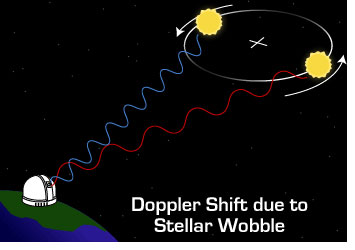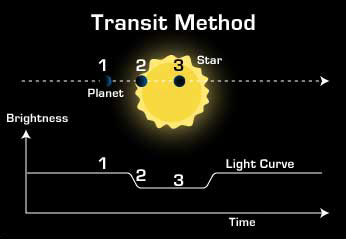Searching for Exoplanets
Searching for exoplanets among the stars is not an easy task. If you could use one phrase to sum up the problem it would be “dark plants and bright stars”. To explain this we look to our own solar system; our sun is 20 billion times brighter than even the largest planet, Jupiter. This is the same in other systems around the universe. The stars are too bright for us to see the planets that orbit them properly. Looking for exoplanets is like looking for a bug near an extremely bright light bulb; it is not easy.
Therefore, scientists must use indirect methods to locate exoplanets. The existence of these planets is captured indirectly, using observed data. Much like trying to catch a criminal with no real proof, and only circumstantial evidence.
There are two methods of indirect detection used:
- Radial Velocity Method (Doppler Spectroscopy)
 (credit: NASA)
(credit: NASA)
In our solar system, we like to think “the Earth revolves around the sun.” However, this is not exactly true. The sun’s gravity pulls on the Earth, and the Earth’s gravity actually pulls on the sun as well. This causes our sun and the Earth to revolve around a common center of gravity. However, because the sun is overwhelmingly heavier than the Earth, the common center of gravity for the two bodies is extremely close to the sun’s center. So much, in fact, that effectively “the Earth revolves around the sun.”
Exoplanets react with their host stars in the same way, where each planet and host star revolve around a common center of gravity. In other words, when a planet orbits a star, that star visibly “wobbles” a small amount. Using this type of indirect proof, if this “wobble” can be detected, there is a good chance a planet exists around the star.
Unfortunately for scientists trying to detect exoplanets, this “wobble” is extremely small. Earth is also so far away from these stars that visibly capturing any effects is difficult. To solve this, an idea was developed to detect any unusual patterns in distant star positions using the Doppler Effect.
The Doppler Effect is a phenomenon where waves (sound and light) appear to expand and contract as they become closer or farther away from an observer. For example, the sound of an ambulance siren changes as it comes toward a person and as it races away. This is how the Doppler Effect works.
If a star with an exoplanet appears to be wobbling, the wavelengths of light that reach the observer (Earth) will expand and contract as that star moves through space. If the expansions and contractions of these wavelengths can be observed, we know the star is periodically wobbling. This means that the observed star has some type of celestial body (an exoplanet) exerting gravitational forces upon it. This is an indirect method for discovering a planet’s existence, called the Radial Velocity Method, or Doppler Spectroscopy.
Incidentally, because of a planet’s large gravitational force, the Doppler Effect is also very large. By observing the period of the expanding and contracting light wavelengths, the revolution cycle of the planet orbiting the star can be understood. By using the Radial Velocity Method, when new exoplanets are discovered, we also are able to predict their mass and orbit cycle.
- Transit Method
 (credit: NASA)
(credit: NASA)
An exoplanet’s orbit can also be directly detected when the planet crosses in front of its host star. The light that reaches Earth from the star dims slightly. This is similar to viewing a solar eclipse of our own sun from Earth, but a much smaller version.
Due to this small “solar eclipse,” the amount of light captured from the host star periodically decreases, which proves the existence of an orbiting planet. This method is called the transit method. By using the transit method, an exoplanet is not only discovered but additional information about the planet can also be calculated.
When observing a transit, the decrease in the change of light can determine the size of the planet. For example, if the amount of light from the host star darkens by 1%, we know the planet’s size is 1% that of its host star. In these cases, it is possible to presume the planet’s size when exoplanets are discovered using the transit method.
In addition, if a planet is discovered by the transit method and its speed is measured by radial velocity (1. Radial Velocity Method), we can assume the planet’s mass. Once the mass and size are both understood, the planet’s density can easily be calculated. In other words, by using these methods together, scientists can predict a lot about each planet they discover; whether it is rocky, has icebergs, is composed of gas, etc.
When using the transit method, light that reaches Earth from the host star may also pass through the planet’s atmosphere. By analyzing this light, the planet’s atmospheric composition can also be predicted.
Although this article doesn’t explain it in detail, in cases where the other side of the host star is hidden, using additional data (called a secondary eclipse), scientists can assume the planet’s surface temperature as well.
The transit method is an extremely powerful tool. Not only does it prove that exoplanets do in fact exist, but it can give us detailed characteristics about each individual planet that is examined.
(文責:佐々木貴教)

